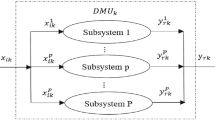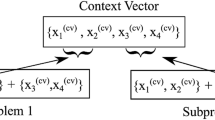Abstract
Dominance Network (DN) analysis has been proposed to assess the efficiency of a set of operating units (OUs) that consume inputs to produce outputs. In a DN, the nodes represent OUs and the arcs correspond to dominance relationships (DR) between them. So far, this analysis has been applied in static scenarios where the OUs belong to the same time period. In this paper, the methodology is extended to the case in which the input and output data refer to multiple time periods tracking the performance evolution of each OU. The proposed Temporal Dominance Network (TDN) contains a node for each OU in each time period. TDN is a weighted directed acyclic graph. There exist contemporaneous DR (between nodes that correspond to the same time period) as well as non-contemporaneous DR (between nodes that correspond to different time periods). The union of these two types of DR defines the TDN. All these DR are transitive, which allows us to represent the TDN by its corresponding skeleton. Various filters and node layouts that can be used to help visualise the TDN are proposed. In addition, a number of network metrics are used to characterise the efficiency of the various OUs in the different periods as well as the corresponding productivity change between any two periods.









Similar content being viewed by others
References
Calzada-Infante, L., & Lozano, S. (2016). Analyzing Olympic games through dominance networks. Physica a Statistical Mechanics and Its Applications, 462, 1215–1230.
Calzada-Infante, L., & Lozano, S. (2020). Some variants and extensions of dominance network analysis. Computers & Industrial Engineering, 141, 106275.
Castelli, L., Pesenti, R., & Ukovich, W. (2010). A classification of DEA models when the internal structure of the decision making units is considered. Annals of Operations Research, 173, 207–235.
Chung, Y. H., Färe, R., & Grosskopf, S. (1997). Productivity and undesirable outputs: a directional distance function approach. Journal of Environmental Management, 51, 229–240.
Cooper, W. W., Pastor, J. T., Aparicio, J., & Borras, F. (2011). Decomposing profit inefficiency in DEA through the weighted additive model. European Journal of Operational Research, 212(2), 411–416.
Cooper, W. W., Seiford, L. M., & Tone, K. (2006). Data envelopment analysis: a comprehensive text with models, applications, references and DEA-solver software (2nd ed.). Springer.
Cooper, W. W., Seiford, L. M., & Zhu, J. (2004). Handbook on data envelopment analysis. Springer.
Fang, T. Y. (2020). Who Is the Keyman? Integrating two-stage DEA and social network analysis to evaluate operational and environmental efficiency in the semiconductor industry. Mathematical Problems in Engineering, 2020, 2926357.
Ghahraman, A., & Prior, D. (2016). A learning ladder toward efficiency: Proposing network-based stepwise benchmark selection. Omega, 63, 83–93.
Guan, J. C., Zuo, K. R., Chen, K. H., & Yam, R. C. M. (2016). Does country-level R&D efficiency benefit from the collaboration network structure? Research Policy, 45, 770–784.
Ho, M. H. C., Liu, J. S., Lu, W. M., & Huang, C. C. (2014). A new perspective to explore the technology transfer efficiencies in US universities. Journal of Technology Transfer, 39(2), 247–275.
Hsieh, H. P., Kuo, K. C., Le, M. H., & Lu, W. M. (2021). Exploring the cargo and eco-efficiencies of international container shipping companies: A network-based ranking approach. Managerial and Decision Economics, 42, 45–60.
Kleinberg, J. (1999). Authoritative sources in a hyperlinked environment. Journal of the ACM, 46, 604–632.
Lee, J., & Choi, G. (2019). A dominance-based network method for ranking efficient decision-making units in data envelopment analysis. Sustainability, 11, 2059.
Leem, B.-H., & Chun, H. (2015). Measuring the Influence of efficient ports using social network metrics. International Journal of Engineering Business Management, 7, 1.
Liu, J. S., & Lu, W. M. (2010). DEA and ranking with the network-based approach: A case of R&D performance. Omega, 38(6), 453–464.
Liu, J. S., Lu, W. M., & Ho, M. H. C. (2014). National characteristics: Innovation systems from the process efficiency perspective. R & D Management, 45(4), 317–338.
Liu, J. S., Lu, W. M., Yang, C., & Chuang, M. (2009). A network-based approach for increasing discrimination in data envelopment analysis. Journal of the Operational Research Society, 60(11), 1502–1510.
Lozano, S. (2014). Company-wide production planning using a multiple technology DEA approach. Journal of the Operational Research, 65, 723–734.
Lozano, S., & Calzada-Infante, L. (2017). Dominance network analysis of economic efficiency. Expert Systems with Applications, 82, 53–66.
Lozano, S., & Calzada-Infante, L. (2018). Efficiency assessment using network analysis tools. Journal of the Operational Research Society, 69(11), 1803–1818.
Lozano, S., & Calzada-Infante, L. (2019). Efficiency ranking using dominance network and multiobjective optimization indexes. Expert Systems with Applications, 126, 83–91.
Lozano, S., & Villa, G. (2004). Centralized resource allocation using data envelopment analysis. Journal of Productivity Analysis, 22, 143–161.
Lozano, S., & Villa, G. (2006). Data envelopment analysis of integer-valued inputs and outputs. Computer and Operations Research, 33(10), 3004–3014.
Lu, W. M., Kweh, Q. L., He, D. S., & Shih, J. M. (2017). Performance analysis of the cultural and creative industry: A network-based approach. Naval Research Logistics, 64, 662–676.
O’Donnell, C. J., Rao, D. S. P., & Battese, G. E. (2008). Metafrontier frameworks for the study of firm-level efficiencies and technology ratios. Empirical Economics, 34, 231–255.
Park, K. S., & Park, K. (2009). Measurement of multiperiod aggregative efficiency. European Journal of Operational Research, 193, 567–580.
Pastor, J. T., & Lovell, C. A. K. (2005). A global Malmquist productivity index. Economic Letters, 88, 266–271.
Simon de Blas, C., Simon Martin, J., & Gomez Gonzalez, D. (2018). Combined social networks and data envelopment analysis for ranking. European Journal of Operational Research, 266(3), 990–999.
Acknowledgements
This research was carried out with the financial support of the Spanish Ministry of Science and the European Regional Development Fund (ERDF), grant DPI2017-85343-P.
Author information
Authors and Affiliations
Corresponding author
Additional information
Publisher's Note
Springer Nature remains neutral with regard to jurisdictional claims in published maps and institutional affiliations.
Appendix
Appendix
1.1 Notation
Let
- \(D = \left\{ {1,2, \ldots ,n} \right\}\):
-
: Set of OUs.
- j,r,p = 1,2,…,n: :
-
Indexes on OUs.
- i = 1,2,…,m: :
-
Index on input dimensions.
- k = 1,2,…,s: :
-
Index on output dimensions.
- \(x_{j} = \left( {x_{1j} ,x_{2j} , \ldots x_{mj} } \right)\):
-
: Input vector of OU j.
- \(y_{j} = \left( {y_{1j} ,y_{2j} , \ldots y_{sj} } \right)\):
-
: Output vector of OU j.
- \(D(r) = \{ j:\;x_{ij} \le x_{ir} \;\forall i\;\; \wedge \;y_{kj} \ge y_{kr} \;\forall k\;\; \wedge \;\left( {x_{j} ,y_{j} } \right) \ne \left( {x_{r} ,y_{r} } \right)\}\):
-
: Set of OUs that weakly dominate OU r.
- \(D_{{}}^{ - 1} (r) = \left\{ {f:r \in D\left( f \right)} \right\}\):
-
: Set of OUs that are dominated by OU r.
- \(D^{*} = \left\{ {r:D\left( r \right) = \emptyset } \right\}\):
-
: Set of non-dominated (i.e. efficient) OUs.
- \(D_{{}}^{*} (r) = \left\{ {\begin{array}{*{20}c} {\left\{ r \right\}} & {if\;r \in D^{*} } \\ {D_{{}} (r) \cap D^{*} } & {if\;r \notin D^{*} } \\ \end{array} } \right\}\):
-
: Set of efficient benchmarks of OU r.
- \(D_{{}}^{ - - 1} (r) = \{ f:f \in D^{ - 1} (r) \wedge D_{{}} (f) \cap D^{*} = \left\{ r \right\} \}\):
-
: Set of OUs dominated by r that have r as their only efficient benchmark.
1.2 Node-level measures
- \(d_{r}^{in} = \left| {D_{{}}^{ - 1} (r)} \right|\) :
-
: In-degree of node r.
- \(d_{r}^{out} = \left| {D(r)} \right|\) :
-
: Out-degree of node r.
- \(s_{r}^{in} = \sum\limits_{{f \in D_{{}}^{ - 1} (r)}}^{{}} {e_{fr} }\) :
-
: In-strength of node r.
- \(s_{r}^{out} = \sum\limits_{j \in D(r)}^{{}} {e_{rj} }\) :
-
: Out-strength of node r.
- \(e_{r}^{\max } = \mathop {\max }\limits_{{j \in D_{{}}^{*} \left( r \right)}} e_{rj}\) :
-
: Distance of node r to its farthest efficient benchmark.
- \(\tau_{r}^{\min } = \mathop {\min }\limits_{{j \in D_{{}}^{*} \left( r \right)}} \;e_{rj}\) :
-
: Distance of node r to its closest efficient benchmark.
- \(\eta_{r} = d_{r}^{out} + d_{r}^{in}\) :
-
: Specificity of node r.
- \(\gamma_{r} = d_{r}^{out} \cdot d_{r}^{in}\) :
-
: Hub index of node r.
1.3 Node-level measures for efficient nodes
- \(\left| {D_{{}}^{ - 1} (j)} \right| = d_{j}^{in}\) :
-
: Benchmarking count of node\(j \in D^{*}\)
- \(\left| {D_{{}}^{ - - 1} (j)} \right|\) :
-
: Benchmarking necessity of node \(j \in D^{*}\)
- \(\kappa_{j} = \sum\limits_{{r \in D_{{}}^{ - 1} (j)}} {e_{rj} }\) :
-
: Benchmarking potential of node \(j \in D^{*}\)
- \(\sigma_{j} = \mathop {\max }\limits_{{r \in D_{{}}^{ - 1} (j)}} \;e_{rj}\) :
-
: inefficiency radius of node \(j \in D^{*}\)
- \(\varphi_{j} = \left| {\left\{ {r:D(r) = \left\{ j \right\}} \right\}} \right|\) :
-
: superefficiency index of node\(j \in D^{*}\)
.
1.4 Network-level measures
- \(d_{{}}^{aver} = \frac{1}{\left| D \right|}\sum\limits_{r \in D}^{{}} {d_{r}^{in} } = \frac{1}{\left| D \right|}\sum\limits_{r \in D}^{{}} {d_{r}^{out} }\) :
-
: Average degree.
- \(\rho = \frac{{d^{aver} }}{\left| D \right| - 1}\) :
-
: Network density.
- \(\Delta = \mathop {\max }\limits_{(r,j) \in E} \;e_{rj}\) :
-
: Network diameter.
- \(\hat{\pi } = \frac{{\left| {D_{{}}^{*} } \right|}}{\left| D \right|}\) :
-
: Percentage of efficient nodes.
- \(\theta^{aver} = \frac{1}{\left| D \right|}\sum\limits_{r \in D} {e_{r}^{\max } }\) :
-
: Average inefficiency score.
Rights and permissions
About this article
Cite this article
Calzada-Infante, L., Lozano, S. Computing multiperiod efficiency using dominance networks. Ann Oper Res 309, 37–57 (2022). https://doi.org/10.1007/s10479-021-04421-5
Accepted:
Published:
Issue Date:
DOI: https://doi.org/10.1007/s10479-021-04421-5




